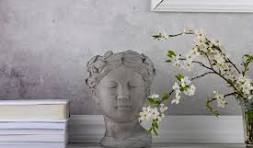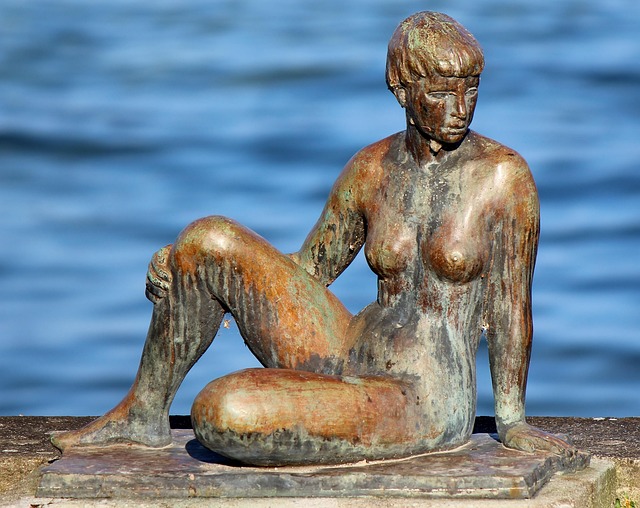
Home » Indoor » Everything You Need to Know About Decorative Sculptures for the Home
What an influential thing art can do in an interior.
How Decorative Sculptures Can Transform Any Room
Choosing the right sculpture to set the mood
How to Make Decorative Sculptures at Home
What are decorative home sculptures?
The distinction between functional and decorative sculptures
The materials that create the wonder sculptures
Select Decorative Sculptures That Suit Your Space
How to pair sculptures with your home style
Shaping size and scale of various spaces
The significance of color in decorative and ornamental sculptures
Mix-and-matching with already-used décor
Activity: Classifying Types of Decorative Sculptures
Sculptures that are modern and minimalistic
Sculptures without the s or fees for a cozy home
Free-spirited bohemian sculptures to add charm
Chic, timeless sculptures with a vintage flair
Sculptures With a Glittering and Sophisticated Feeling
Standard Materials for Decorative Sculptures
The most significant Expression of Natural Beauty: Wooden sculptures
Metal sculptures: Striking, glide, and present
Ceramic and porcelain sculptures are featherweight and delicate.
Frosted glass sculptures: Next-level street art
Stone sculptures: Naturalistic and rugged
Resin sculptures: Enterprising design that’s easy on the wallet
How to Position Decorative Sculptures for Maximum Impact
Focal points: Display above the living room table and foyer
Decorative sculptures in surprising places
Sculptures for the bedroom that help create a peaceful atmosphere
Sculptures in the kitchen that kick up the style
Why outdoor sculptures are incredible to add to your garden space
Arranging sculptures for the aesthetic effect
Finding balance in asymmetrical sculptures
Sculpture Additions: Creating visual height and depth
Plucking a S sitter: What to consider So, this sculpture on a shelf or mantel: What truly lifts best
Sculpture & Temporary Sections: Making Thematic Vignettes
Using Decorative Sculptures in Different Rooms
How to Redesign Your Living Room with Sculptures
Sculptures Add Personal Touch to Your Bedroom
Stylish but functional home office sculptures
Adding dimensions of art to a dining space
Adding intrigue with hallway sculptures
How Decorative Sculptures Impact Your Home’s Aesthetic
How sculptures improve the atmosphere of a room
Finding conversation starters in sculptures
Showpiece sculptures as forms of self-expression
Bringing a room’s look together with sculptures that fight with art
Theme and Mood Selection of Sculptures
Crafts to create a calm and peaceful environment
Dramatic effect: Statement sculptures in bold design
Fun and flamboyant sculptures to brighten up
Sculptures relating to nature and the outdoors
Having sculptures as part of the story of your home
How to select sculptures that resonate with your personality
Cultural fusions cross borders, and decorative sculptures drape the walls.
Create a narrative with your sculptures.
Emotionally connected with the sculptures in your space
The Home Trend Report: Decorative Sculptures
These sculptural pieces are taking over the design world.
Sculptures that are eco-friendly and sustainable
Home interactive and kinetic sculptures
The emergence of digital and novel sculptures
Caring for & Maintaining Decorative Sculptures
How to clean sculptures and not damage them
How to take care of metal, wood, and glass sculptures
Dust, light, and moisture protection for sculptures
These should include supporting sculptures with slots or table supports, custom tulip shapes for holding protruding sculptures, and housing sculptures in proper off-site storage devices.
Cheap Home Decorative Sculptures
Where to buy inexpensive decorative sculptures
How to sculpt at home: DIY sculpture guides
Turning materials into sculptures for the home
Sculptures shopping at thrift stores and flea markets
How to Combine Decorative Sculptures With Other Mediums
Mixing sculptures with paintings and photographs
How sculptures and textiles come together in your decor
How to use sculptures with furniture for a comprehensive design
Collectible Home Decor with Decorative Sculptures: Gift Suggestions
Gift sculptures that matter to friends, family
How to start a sculpture collection: What to know
How to pick collectible sculptures that increase in value
For the newest data, you can think of your home as a decorative sculpture.
Where sculptures are a must in your living space décor
Discover the ideal sculptures that capture the essence of your style.
Last words of advice to maximize the success of decorative sculptures

Report: Why Decorative Sculptures for the Home Are Important
Art has always been at the heart of interior design, with the power to make or break a room. Decorative sculptures are potent expressions of creativity and style when it comes to taking a room’s aesthetic to the next level. Whether it’s a contemporary abstract shape or a classical sculpture of a bust, figurative sculptures bring a unique texture and dimension to your decor.
They don’t just occupy space; they animate it. Equally selected sculptures can be a reflection of your personality, communicate feelings, or be stunning conversation starters.
The correct sculpture has the power to endeavor the room, to endow it with character and purpose. It can be big and bold, soft and quiet, whimsical and playful. A decorative sculpture that’s been thoughtfully selected does much more than fill a corner — it becomes part of the essence of the room.
The A To Z Of Decorative Sculptures For Home
Decorative sculptures are three-dimensional art pieces designed primarily for their aesthetic benefits to be enjoyed in home decor. Functional-style sculptures may be selected, if utilitarian, to serve a functional purpose, unlike decorative sculptures, which are chosen for their aesthetic beauty and the ambiance they create within a space.
From stylish porcelain forms to minimalist metallics, the world of decorative sculptures is massive, so they are among the most versatile and tasteful home decor styles that you can choose from.
Both functional and decorative sculptures are some of the most beautiful forms of art, but their goals are different. Functional sculptures can be very utilitarian, serving some task or purpose, like a lamp or vase. On the flip side, decorative sculptures are more about aesthetics and artistic expression. While these sculptures don’t have a functional role, they play a key part in highlighting a space’s atmosphere and elevating its visual storytelling.

When it comes to sculptures, materials are a key part of the discussion. Whether chiseled from stone, shaped from clay, or formed from metal, the material shapes both the aesthetics of the sculpture and its longevity. Materials like metal are excellent for a more modern, industrial feel, whereas ceramic or wood can add warmth and a more organic feel to a room.
Tips for Selecting Decorative Sculptures for Your Room
There are many considerations to be made when choosing the ideal sculpture. First, a sculpture must fit your home’s style. If your home is spare, a simple, clean-lined sculpture can punctuate the space without overwhelming it. Conversely, a bold and ornate work could be ideal for a traditional or eclectic environment.
Size and scale are also important considerations when choosing a sculpture. If it’s too small, the sculpture may get lost in the space; if it is too large, it risks taking control of the room. A thoughtfully selected sculpture should scale proportionately in the space and relate to other features in the room.
The sculpture’s color also plays an integral part in its impact. A brightly colored sculpture can turn up the volume (and create a talking point) in a neutral room. Metallic or monochromatic sculptures, on the other hand, bring a chic, subtle refinement to the space.
Mixing and matching sculptures with more traditional decor can create harmony in the space. Not all sculptures have to be individual works. When placed among other furniture or art and thoughtfully arranged, they can tell a cohesive visual narrative.
Pillars of Inspiration: Decorative Sculpture Styles
Decorative sculptures come in all forms for all kinds of rooms. Everything from modern and minimalist to rustic and organic, there’s a sculpture style to suit every taste.

Modern sculptures and minimalist sculptures focus on clean lines and geometric shapes with a minimalist approach to design. These sculptures often skew toward the abstract and prioritize form over detail. They can work well in a contemporary or industrial setting.
An earthy collection of rustic sculptures made from materials like wood or stone exude warmth and connection to the outside. These pieces have a grounded, earthy quality, ideal for warm spaces or dwellings with an eco-conscious feel.
If you prefer a more eclectic, free-spirited style, then bohemian sculptures are for you. And often, they’re brightly colored and abstractly shaped — so a few blobs or a striking piece can inject character and whimsy into a room.
For that touch of timelessness, vintage-inspired sculptures bring nostalgia and refinement. These sometimes feature ornate detailing and classic forms that add sophistication to a traditional or vintage-themed room.
Luxury and sophistication are often exuded through rare materials such as marble or bronze, paired with fine craftsmanship. They make for great statement pieces – large, imposing, and luxurious additions to a room’s design.
Commonly Used Materials for Decorative Sculptures
The type of material used for a sculpture often influences its texture, look, and resilience. Every material has a distinct characteristic, and you can select the one that suits your home’s architecture.
A wooden sculpture makes any room feel warm and natural. The wood grains and textures provide a sensual, organic beauty to these designs, making them attractive for rustic, country-style, or eclectic interiors.

Metal sculptures, with their sleek and polished finishes, add a contemporary and daring touch to any space. The mirrored surfaces make them sophisticated, and you can use them to complement industrial, modern, or minimalist spaces.
There is an ageless beauty in ceramic and porcelain sculptures. These materials are often finely detailed, evoking a refinement best suited to more traditional or formal environments.
Glass sculptures give a nuanced and transparent note involved in fragile beauty. They’re generally colorful and ethereal, which makes them well-suited to contemporary or artistic environments.
Stone sculptures, rough-hewn or smoothly chiseled, evoke a grounded, earthy sensibility. Ideal for nature-inspired decor, they add weight and permanence to a room.
While resin sculptures are still relatively inexpensive, the look packs a punch. Also shaped to imitate other materials such as stone or wood, resin sculptures are perfect for people seeking breathtaking art on a budget.
Decorative Sculptures: Where to Place for Big Impact
The positioning of a sculpture is as essential as its making. Some spaces within the home where the sculpture can dramatically/soothingly amplify its visual delight.
Living rooms and entryways provide natural focal points for decorative sculptures. An eye-catching sculpture inside the entrance immediately establishes the mood for the visitors, and an assertive piece in your living room can capture attention and stimulate discussion.
Surprising results can also come from unexpected placements. A sculptural piece, such as one shown in a bathroom or hallway, adds intrigue and elevates spaces that can go unnoticed.
In addition, sculptures can also be used in the bedroom to establish a peaceful ambiance. An understated piece on a nightstand or an enormous sculpture at the foot of the bed can bring a soothing presence to the room.
In the kitchen, sculptures can bring character and drama. Whether on countertops or shelves, they add a layer of accessible artistic beauty to this practical space.
Outdoor art can liven up your garden or patio. From modern stainless-steel art to natural stone shapes, sculptures can complement the native beauty of outdoor areas.
Decorative Sculptures: How to Style Them in Your Home
There is an art to styling decorative sculptures. The arrangement, spacing, and balance of sculptures can have a significant impact on their effect.
It ties together in a cohesive visual statement when grouping sculptors. A group of more miniature sculptures can form an interesting grouping, much like the way a gallery wall can be arranged. Classifying sculptures according to themes, materials, or colors can also create visual harmony.
The key to styling sculptures is balance. Using something asymmetrical can introduce an interesting dynamic to the room, but you have to place it wisely so it doesn’t dominate. By using both larger and smaller sculptures, you can achieve a certain harmony in the decor.
Sculptures can also be employed to establish visual height and depth in a room. Tall sculptures can draw the eye upward and make a space seem larger, while low, wide sculptures can ground a room and provide a counterbalance to more open-plan spaces.
Shelves and mantels are great spaces for sculptures. Whether on their own or as a part of a more extensive collection, sculptures in these spaces can bring grace and personality. Try different heights and alignments to find what you like the most.
Thematic vignettes with sculptures tell a story in a room. For example, a grouping of nature-inspired sculptures could be oriented next to a small potted plant and a painting of a forest, creating a harmonious, natural composite vignette.
Decorative Sculptures and Its Placement in Various Places
In the right-placed room, sculptures can also add so much to the style.

Sculptures can be used as dramatic focal or subtle accents in the living space, whether you place a large statement piece to become the focal point of the room or use more miniature sculptures to add intricate details to the overall design.
A restful escape, the bedroom can also be enhanced with sculptures that inspire calm and peace. A calming, contemplative sculpture — maybe a figure in a meditative pose — can reinforce the room’s restful mood.
Sculptures can definitely add sophistication and creativity in the office at home. Abstract or geometric sculptures can be productive, but more personal ones can give the room a special character of your own.
A dining room is a space for gathering and conversation. A beautiful sculpture atop the dining table or sideboard can help foodies start right off with a central topic during meal time, in addition to enhancing their meal-time experience.
Hallways are neglected in the decoration process, but ideally, you can use sculptures to add unexpected variety and stimulation. A long hall can be enhanced by a line of sculptures placed at intervals leading the eye to the end of the hall.
How Decorative Sculptures Can Affect Your Home Aesthetic
Sculptures subtly but meaningfully influence the mood and atmosphere of a room. The best sculpture can turn a bland room into an active, throbbing one, while one that is more meditative can soothe a room to make it seem calm and welcoming.
Statues are conversation starters. They become talking pieces to serve the house guests, which leads you to learn about their unique forms, materials, and meanings. They add life to a room, not only with their physical presence but also with potential stories they might tell.
Sculptures are personal expressions that may convey emotions, beliefs, or elements of the homeowner’s personality. Every piece contributes to the overall narrative of the home, providing insight into the tastes and values of those who inhabit it.
Sculpture can be the finishing touch that brings a room’s look together. Placed strategically, they integrate smoothly with the room’s colors, furniture, and other design elements, building a harmonious, cohesive space.
Choosing Sculptures for Particular Themes and Moods
Sculptures can elicit certain moods or amplify particular themes within your home.
Sculptures with organic, flowing lines or those made with natural materials like wood or stone can add a peaceful vibe to a tranquil environment. A delicate, curvilinear sculpture in a bedroom or living room can soften the atmosphere.
Dramatic statement pieces in bold colors or geometric shapes bring a space to life. These items create a substantial visual impact and can be used to inject energy and excitement into neutral or minimalistic rooms.
For those looking for a playful or quirky vibe, sculptures that use humor or atypical shapes bring a sense of fun. Abstract, colorful, or lighthearted designs have a place in spaces designed for relaxation and enjoyment.
Sculptures inspired by nature allow you to bring the outdoors in. Whether animals, plants, or landscapes, these sculptures convey the beauty of nature and create a calm, earthy atmosphere in any room.
This New 3D Sculpture System is Both an Art and a Home in One.
Sculptures can Encapsulate your personality, interests, or life experiences. Selecting pieces that align with your values or represent moments in your life can lend your home additional meaning.
Decorative sculptures may also reflect cultural influences, either through the artistry of a specific region or the traditions of a singular community. These sculptures can also serve as symbolic representations of heritage that can be proudly displayed.
Sculptures also tell stories. Such a piece can resonate, evoke a memory, an idea, a longing, and that abstraction carries so much weight for the viewer. The magic of sculpted form is they can speak to a place when words often cannot.
Choose sculptures with emotions that resonate with you. A piece that has a personal connection to you will add a touch of authenticity and warmth to the narrative of your home.
Artistic Accents: here are some decorative sculptures for the home
Cold weather decorating is back, so get inspired by the latest trends in decorative sculptures and transform your home!
All of these sculptural pieces, which are taking the design world by storm, now combine contemporary aesthetics with traditional craftsmanship. After all, metal sculptures give way to abstract innovation and artistry, while the latest customized designs take the industry sky-high.
Sustainable and eco-friendly sculptures have emerged in recent years. Artists are now creating earth-friendly works of art with recycled materials, repurposed objects, and natural elements.
There’s a growing demand for interactive and kinetic sculptures. These kinetic sculptures offer a vibrant and active relationship between the viewer and the art, which is why they are such an exciting feature for contemporary interiors.
Last but not least, the emergence of digital and futuristic sculptures is rapidly expanding the walls of art paper. A new generation of sculptors is using 3D printing and digital design tools to incorporate technology and innovation into their work.
Decorative Sculptures Care and Maintenance
Sculptures need proper care and maintenance to look as beautiful as they were the day you placed them.
Cleaning sculptures should be done carefully with gentle tools like a microfiber cloth or a soft brush. Harsh cleaning agents or abrasive materials may damage delicate surfaces, as in the case of sculptures made from glass, wood, or ceramics.

How you care for it depends on the material. Metal sculptures need polishing every once in a while to keep them shiny, and wood sculptures might need an oiling once in a while to keep the wood pattern beautiful.
The associated upkeep of sculptures involves shielding them from pollutants, sunshine, and humidity. Avoid mushy bugs, and try not to display in areas with too much direct sunlight or moisture, which can warp or discolor a sculpture over time.
This is where proper storage for the sculptures comes into play when the sculptures are not in use. Please do not keep them in wet or too-warm locations. Use protective cases or wrap the sculpture in a soft cloth if it is delicate.
Cheap Decorative Sculptures for the Home
Or decorative sculptures, which do not need to be expensive. There are many different ways to bring beautiful sculptures into your home that won’t break the bank.
Inexpensive sculptures can be readily found at flea markets, art fairs, and Internet sites that specialize in inexpensive art. When the materials and craftsmanship may not match those of high-end pieces, these sculptures can still deliver plenty of visual pop and pizzazz.
For you, artsy folks with some extra time on your hands, DIY sculptures are a great choice. Imagine how unique these pieces would be if you crafted them yourself! Even beginner-level sculpting can produce impressive results with the right materials.
Up cycling materials into sculptures is another inexpensive option when it comes to home decoration. Through the use of recycled goods such as scrap metal, bits of wood, or even old furniture, you can make custom fixtures that create a story while incorporating them into your home’s overall decor.
You can also find extraordinary sculptures for a fraction of the cost at thrift stores and flea markets. Such vintage and second-hand stores usually feature captivating pieces that can introduce character and uniqueness to your home.
Mixing Up Decorative Sculptures With Other Art Forms

Sculptures don’t have to stand alone. When paired with other art forms — paintings, photographs, or textiles — they can make for a dynamic, visually rich space.
When mixing sculptures with paintings, be mindful of how they interact with each other. Sculptures with bold lines or geometric forms can provide a nice contrast to a landscape painting’s gentle curves. Fluid statues may pair nicely with abstract pieces that celebrate organic shapes.
Another success reminds us of the complementarity between sculptures and textiles in order to amplify the aesthetics of a room. Sculptures can be placed against sumptuous fabrics like velvet or linen, which contrasts tactility with the pieces and lifts a room’s ambiance.
Sculptures can also engage in a conversation with furniture. Mixing a sleek, modern sculpture with mid-century modern furniture can reinforce a particular design style, while juxtaposing an audacious piece with traditional furniture may create a more layered and stylishly eclectic feel.
Sculptural decor for the home: Gifts and collectibles
Sculptures are meaningful gifts. Whether generic, bemusing, or even confusing, a carefully curated sculpture for a birthday, anniversary, or special occasion can convey intentional thoughtfulness and appreciation. Think about giving a work that reflects the recipient’s taste, lifestyle, or interests.
The Joint Adventure of Getting Started Artwork. It’s essential to do your research and invest in pieces that resonate with you individually. Collectible sculptures are not only beautiful and appealing, but they can be valuable, too!
Collectible sculptures: Explore the factors that determine the value of collectible sculptures, such as authenticity, rarity, and potential for appreciation. Look for works by famous artists or limited edition works that provide exclusivity.
In conclusion, decorative sculptures can help bring your home to life.
Sculptures are not just functional decorative pieces; they bring an artistic promise and sculpt your home with character and life. They can express your personality, narrate a story, and establish the feel of your space. By choosing and positioning sculptures that match your style, you’ll be able to enhance your home’s decor and make it feel as though it is as unique and vibrant as you are.
FAQs Common Queries about Decorative Home Sculptures
What are decorative home sculptures?
They are artistic designs made to beautify the appearance of your home. They can be abstract or figurative and can be made of any material — wood, metal, ceramic, glass, or stone.
How do I select the right sculpture for my home?
Take the style of your home into account when choosing a sculpture. Contemporary homes may look better with abstract or geometric sculptures, while traditional or rustic interiors may suit nature-inspired or figurative sculptures more. You might also want to consider the size, material, and color to match your existing décor.
Where do I put a decorative sculpture?
Decorative sculptures can go on shelves, mantels, coffee tables, or side tables. More enormous sculptures can be stood in large open areas such as at an entrance or in the middle of a room as an eye-catcher.
What are decorative home sculptures made of?
Common materials include wood, metal (stainless steel or iron), ceramic, glass, resin, stone (marble or granite), and even eco-friendly materials, such as recycled products. The material can influence the style and longevity of the sculpture.
Are decorative sculptures easy to care for?
Almost all decorative sculptures require little, if any, maintenance. Materials such as wood require the occasional polishing or cleaning, and metal sculptures need to be dusted periodically to prevent tarnishing. Thin-walled glass sculptures have to be handled very carefully, or they break.
How should I take care of my decorative sculptures?
Keep your sculpture beautiful by dusting it once in a while with a soft cloth or duster. When appropriate, apply a light cleaning solution that is appropriate for your particular type of sculpture (such as metal polish for metal sculptures or gentle cleaner for ceramic pieces).
How do decorative sculptures continue to be used outdoors?
However, some decorative sculptures, especially those made from weather-resistant materials such as stone, metal, or resin, can be used outdoors. Nevertheless, sculptures situated outside might need more attention, such as shielding against extreme weather.
What is the difference between decorative sculptures and functional sculptures?
Decorative sculptures are made more for aesthetic pleasure than practical function. In contrast, functional sculptures serve a useful purpose, like being parts of furniture or holding items (think sculptural lamp bases or bookends).
May I order a custom decorative sculpture?
Customization is vast, though, and many artists and manufacturers are offering it (as well as part replacements). You can unpack the specific designs, colors, or sizes to accommodate your personal style and home décor. Custom sculptures can free your living space from the ordinary.
Are decorative sculptures a good way to invest?
Decorative sculptures, by definition, are meant to beautify and make a place more interesting. While most are not necessarily inherently increases in value, some are objects made by famous artists and can, therefore, be considered marketable and even collectible items.
<script type="application/ld+json">
{
"@context": "https://schema.org",
"@type": "BlogPosting",
"mainEntityOfPage": {
"@type": "WebPage",
"@id": "https://homesnhouses.com/decorative-home-sculptures/"
},
"headline": "Best Decorative home sculptures-2025",
"image": "https://homesnhouses.com/wp-content/uploads/2025/04/decorative-home-sculptures-11.jpeg",
"author": {
"@type": "",
"name": ""
},
"publisher": {
"@type": "Organization",
"name": "homesnhouses",
"logo": {
"@type": "ImageObject",
"url": "https://homesnhouses.com/wp-content/uploads/2025/04/decorative-home-sculptures-2.jpg"
}
},
"datePublished": ""
}
</script>
